Gulls and Terns
|
Order: CHARADRIIFORMES - Family: LARIDAE |
| 100 Species currently existing - 29 in region + 5 vagrants + 2 rare |
Gulls and terns are two distinct groups of seabirds known for their coastal habitats, distinctive appearances, and behaviors. Here are some key points about gulls and terns: Read in Spanish
GULLS
Physical Characteristics: Gulls are medium to large-sized birds with webbed feet, long wings, and strong bills. They have a distinctive angular shape in flight and can be identified by their white and gray plumage, though some species have more colorful markings. Gulls also have broad heads and keen eyesight.
Habitat: Gulls are highly adaptable and are found in a wide range of coastal and inland habitats, including beaches, estuaries, lakes, and urban areas. They are often seen scavenging for food near human settlements, as well as foraging along shorelines and in open waters.
Diet: Gulls are opportunistic feeders and have a varied diet that includes fish, invertebrates, small mammals, carrion, and human food scraps. They are known for their bold behavior in stealing food from other birds or even humans.
Behavior: Gulls are social birds that are often seen in large flocks, especially during the non-breeding season. They are vocal and have a wide range of calls for communication. Gulls also exhibit complex behaviors such as aerial displays, territorial defense, and courtship rituals.
TERNS
Physical Characteristics: Terns are smaller than gulls and are characterized by their slender bodies, pointed wings, forked tails, and sharp, pointed bills. They have graceful flight patterns and are superb aerial hunters. Terns typically have a more streamlined and elegant appearance compared to gulls.
Habitat: Terns are primarily found in coastal areas, nesting on beaches, islands, and coastal marshes. They are well adapted for diving into the water to catch fish, their primary source of food.
Diet: Terns are piscivorous birds, which means they mainly feed on fish. They are known for their spectacular plunge-diving behavior, where they hover over the water and then dive headfirst to catch fish with precision. Terns also eat crustaceans and other small marine creatures.
Behavior: Terns are known for their acrobatic flight displays, with some species engaging in elaborate aerial courtship rituals. They are highly vocal birds, with various calls used for communication, navigation, and social interactions. Terns are also migratory birds, undertaking long-distance journeys between their breeding and wintering grounds.
Gulls and terns are both important components of coastal ecosystems, each with unique adaptations and behaviors that allow them to thrive in marine environments. While gulls are known for their opportunistic feeding habits and adaptability, terns are celebrated for their graceful flight and precision fishing skills. Both groups play crucial roles in maintaining the balance of coastal food webs and ecosystems.
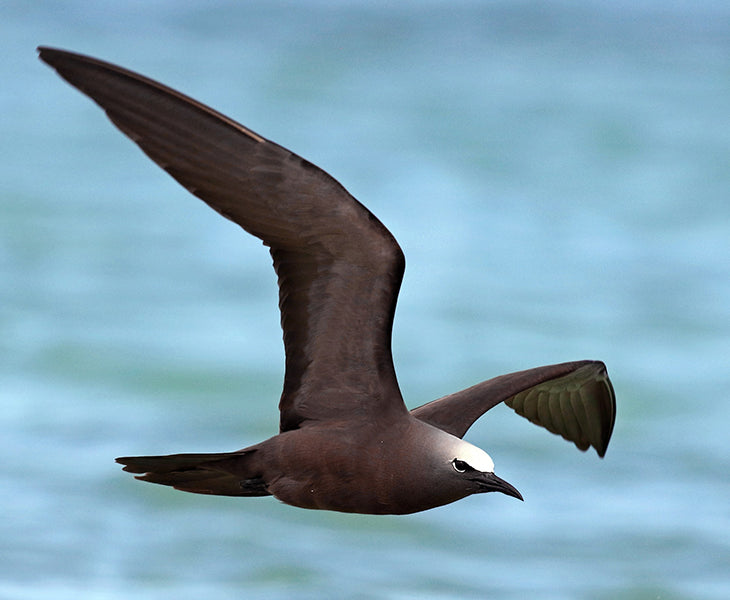
Brown Noddy
Anous stolidus
Spanish Name: Tiñosa Parda
Size: 15 in | 38 cm
Habitat: Pelagian waters
Height: Sea level
Photo: © Luke Seitz eBird S27904475 Macaulay Library ML 34482701

Black Noddy
Anous minutus
Spanish Name: Tiñosa Negra
Size: 14 in | 36 cm
Habitat: a variety of marine environments, including tropical and subtropical waters around coral reefs, atolls, and rocky islands.
Height: Sea level
Photo: © slowmotiongli iStock/Getty Images Plus

Common White Tern (White Tern)
Gigys alba
Spanish Name: Gaviotín Niveo
Size: 13 in | 33 cm
Habitat: tropical and subtropical oceanic regions.
Height: Sea level
Photo: © Pascale Gueret iStock/Getty Images Plus
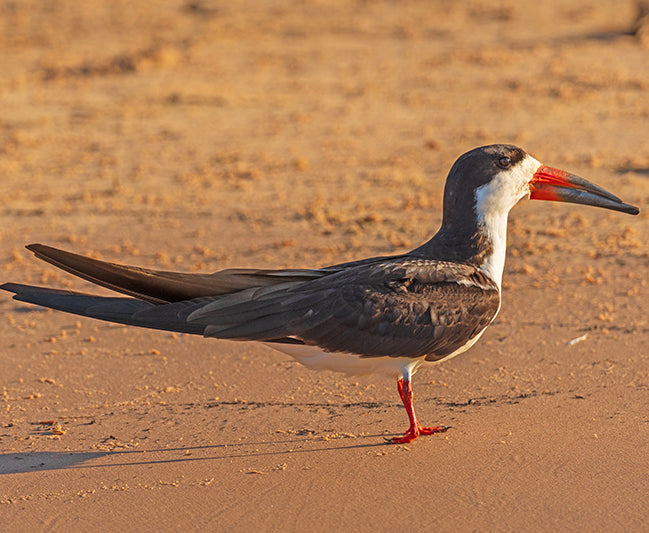
Black Skimmer
Rynchops niger
Spanish Name: Picotijera Americano
Size: 18 in | 46 cm
Habitat: Sandy beaches, tidal flats, sandbars, and shallow coastal lagoons.
Height: <1000 m
Photo: © Wildnerdpix iStock/Getty Images Plus

Little Gull
Hydrocoloeus minutus
Spanish Name: Gaviota Enana
Vagrant
Size: 11.5 in | 29 cm
Habitat: Freshwater and brackish coastal areas such as lakes, rivers, marshes, and estuaries.
Height: Sea level
Photo: © Cameron Eckert eBird S7259518 Macaulay Library ML 81497591

Swallow-tailed Gull
Creagrus furcatus
Spanish Name: Gaviota Rabihorcada
Rear Resident
Size: 21 in | 53 cm
Habitat: Freshwater and brackish coastal areas such as lakes, rivers, marshes, and estuaries.
Height: Sea level
Photo: © Peter Kaestner eBird S35664265 Macaulay Library ML 57117331

Sabine's Gull
Xema sabini
Spanish Name: Gaviota de Sabine
Rare boreal passage migrant (Sept - late May)
Size: 13.5 in | 34 cm
Habitat: Highly pelagic, spending much of their time far out at sea, particularly over continental shelves.
Height: Sea level
Photo: © Daniel López-Velasco | Ornis Birding Expeditions eBird S67965517 Macaulay Library ML 237435121

Black-headed Gull
Chroicocephalus ridibundus
Spanish Name: Gaviota Cabecinegra
Size: 16 in | 41 cm
Habitat: Wetlands, such as lakes, rivers, ponds, marshes, and estuaries.
Height: Sea level
Photo: © OKU iStock/Getty Images Plus

Andean Gull
Chroicocephalus serranus
Spanish Name: Gaviota Andina
Rarely coastal
Size: 19 in | 48cm
Habitat: Near lakes, marshes, and other wetland areas in the Andes Mountains, often at high elevations.
Height: 3000 - 5000 m
Photo: © Blake Matheson eBird S40224954 Macaulay Library ML 74820331

Gray-headed Gull (Gray-hooded Gull)
Chroicocephalus cirrocephalus
Spanish Name: Gaviota Capucho Gris
Size: 17 in | 43 cm
Habitat: Estuaries, beaches, marshes, lakes, and rivers. They can also be found in urban areas, agricultural fields, and even at high elevations near freshwater lakes.
Height: Sea level
Photo: © Christoph Moning eBird S16732047 Macaulay Library ML 65681601

Gray Gull
Leucophaeus modestus
Spanish Name: Gaviota Gris
Rare austral migrant
Size: 18 in | 46 cm
Habitat: Coastal areas, including rocky shorelines, beaches, estuaries, and ports.
Height: Sea level
Photo: © Oscar Gutierrez Zozulia iStock/Getty Images Plus

Franklin's Gull
Leucophaeus pipixcan
Spanish Name: Gaviota de Franklin
Common boreal migrant
Size: 14.5 in | 37 cm
Habitat:
Height: Sea level
Photo: © Akchamczuk iStock/Getty Images Plus

Laughing Gull
Leucophaeus atricilla
Spanish Name: Gaviota Reidora
Common boreal migrant
Size: 16.5 in | 42 cm
Habitat: Coastal regions, including beaches, estuaries, marshes, and lagoons.
Height: <2600 m
Photo: © Dorian Anderson eBird S55259417 Macaulay Library ML 154520481
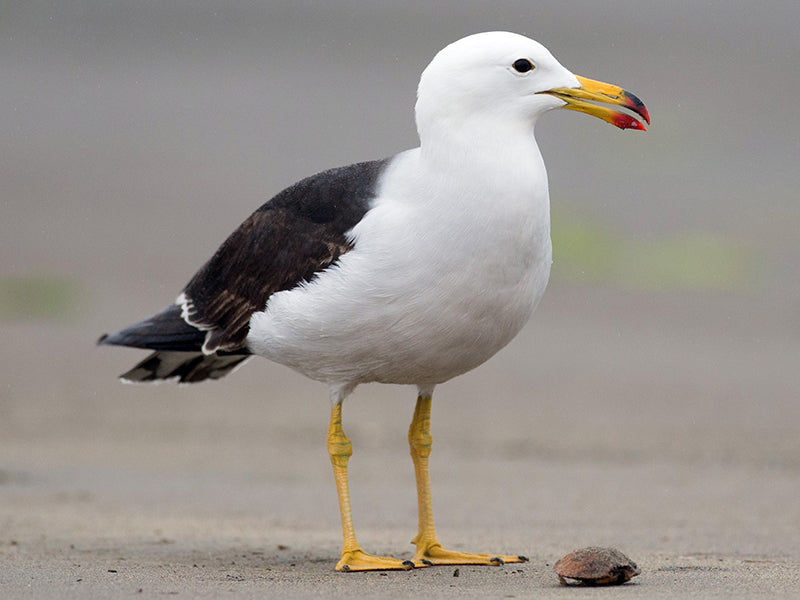
Belcher's Gull
Larus belcheri
Spanish Name: Gaviota Sureña
Size: 22 in | 56 cm
Habitat: Rocky coastlines, islands, and coastal cliffs where they nest and roost.
Height: Sea level
Photo: © Chris Wood eBird S40486650 Macaulay Library ML 77582251

Ring-billed Gull
Larus delawarensis
Spanish Name: Gaviota de Delaware
Rare boreal Migrant
Size: 18 in | 46 cm
Habitat: Coastlines, lakes, rivers, and urban areas.
Height: Sea level
Photo: © Nancy Strohm iStock/Getty Images Plus

Kelp Gull
Larus dominicanus
Spanish Name: Gavión Cocinero
Very rare visitor
Size: 24 in | 61 cm
Habitat: Rocky cliffs, sandy beaches, and coastal areas.
Height: Sea level
Photo: © Cristian Valderas Vargas iStock/Getty Images Plus

Lesser Black-backed Gull
Larus fuscus
Spanish Name: Gaviota Sombría
Size: 21 in | 53 cm
Habitat: Coastal areas, wetlands, and urban environments.
Height: Sea level
Photo: © Sander Meertins iStock/Getty Images Plus

Arctic Herring Gull ( Herring Gull)
Larus smithsonianus
Spanish Name: Gaviota Argéntea del Ártico
Size: 25 in | 64 cm
Habitat: Coastlines, lakes, and rivers.
Height: Sea level
Photo: © paulfjs iStock/Getty Images Plus

Great Black-backed Gull
Larus marinus
Spanish Name: Gavion
Vagrant
Size: 30 in | 76 cm
Habitat: Estuarine habitats, where rivers meet the sea.
Height: Sea level
Photo: © David O'Brien iStock/Getty Images Plus
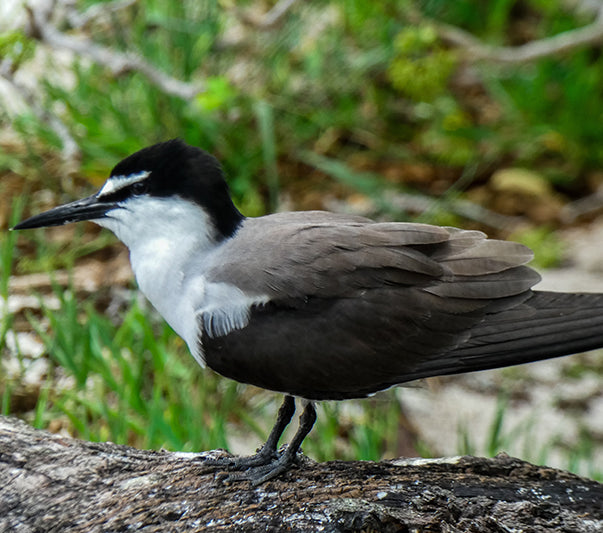
Sooty Tern
Onychoprion fuscatus
Spanish Name: Gaviotín Oscuro
Size: 16 in | 41 cm
Habitat: Highly adapted for life at sea.
Height: Sea level
Photo: © valsmith56 iStock/Getty Images Plus

Bridled Tern
Onychoprion anaethetus
Spanish Name: Gaviotín Embridado
Size: 15 in | 38cm
Habitat: Tropical and subtropical regions around the world.
Height: Sea level
Photo: © Samantha Haebich iStock/Getty Images Plus
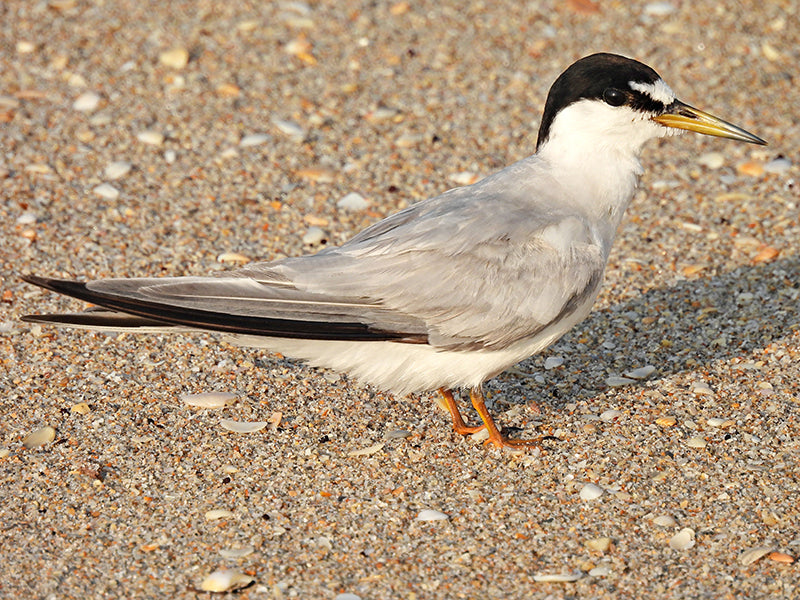
Least Tern
Sternula antillarum
Spanish Name: Gaviotín Enano
Size: 9 in | 23 cm
Habitat: Coasts and inland waterways. Sandy beaches, barrier islands, salt flats, and occasionally breed inland along rivers and lakes.
Height: Sea level
Photo: © passion4nature iStock/ Getty Images Plus

Yellow-billed Tern
Sternula superciliaris
Spanish Name: Gaviotín Fluvial
Size: 10 in | 25 cm
Habitat: Rivers, freshwater lakes but not in coasts.
Height: <1000 m
Photo: © Dgwildlife iStock/Getty Images Plus

Large-billed Tern
Phaetusa simplex
Spanish Name: Gaviotín Picudo
Size: 16 in | 41 cm
Habitat: In large muddy rivers in lowlands.
Height: <1000 m rarely 3500 m
Photo: © drferry iStock/Getty Images Plus

Common Gull-billed Tern
Gelochelidon nilotica
Spanish Name: Gaviotín Blanco
Size: 14 in | 36 cm
Habitat: Salt marshes, estuaries, beaches, and coastal lagoons.
Height: Sea level
Photo: © Jesse Amesbury eBird S36602060 Macaulay Library ML 57046791

Caspian Tern
Hydroprogne caspia
Spanish Name: Gaviotín Piquirrojo
Size: 21 in | 53 cm
Habitat: A variety of aquatic habitats, including coastlines, estuaries, marshes, lagoons, and large inland bodies of water.
Height: Sea level
Photo: © Ulrich Roesch iStock/Getty Images Plus

Inca Tern
Larosterna inca
Spanish Name: Gaviotín Inca
Size: 17 in | 43 cm
Habitat: Along rocky coastal cliffs and islands, where they nest in colonies.
Height: Sea level
Photo: © Martina Sliger iStock/Getty Images Plus

Black Tern
Chlidonias niger
Spanish Name: Gaviotín Negro
Size: 10 in | 25 cm
Habitat: Near marshes, lakes, ponds, and slow-moving rivers during the breeding season.
Height: Sea level
Photo: © mirceax iStock/Getty Images PLus

Roseate Tern
Sterna dougallii
Spanish Name: Gaviotín Rosado
Vagrant
Size: 13 in | 33 cm
Habitat: Coastal regions around the world, typically breeding on remote islands, sandy beaches, and coastal marshes.
Height: Sea level
Photo: © BrianScantlebury iStock/Getty Images Plus

South American Tern
Sterna hirundinacea
Spanish Name: Gaviotín Sudamericano
Size: 13 in | 33 cm
Habitat: Coastal areas, including rocky shores, sandy beaches, and estuaries.
Height: Sea level
Photo: © Marco Valentini eBird Checklist S64996311 Macaulay Library ML 204575031

Common Tern
Sterna hirundo
Spanish Name: Gaviotín Común
Size: 12 in | 30 cm
Habitat: Along coastlines, including sandy beaches, estuaries, marshes, and offshore islands. They also breed in inland areas near suitable freshwater habitats like lakes and rivers.
Height: Sea level
Photo: © neil bowman iStock/Getty Images Plus

Arctic Tern
Sterna paradisaea
Spanish Name: Gaviotín Ártico
Size: 12 in | 30 cm
Habitat: Arctic regions, nesting on coastal tundra or rocky islands.
Height: Sea level
Photo: © John Pennell iStock/Getty Images Plus
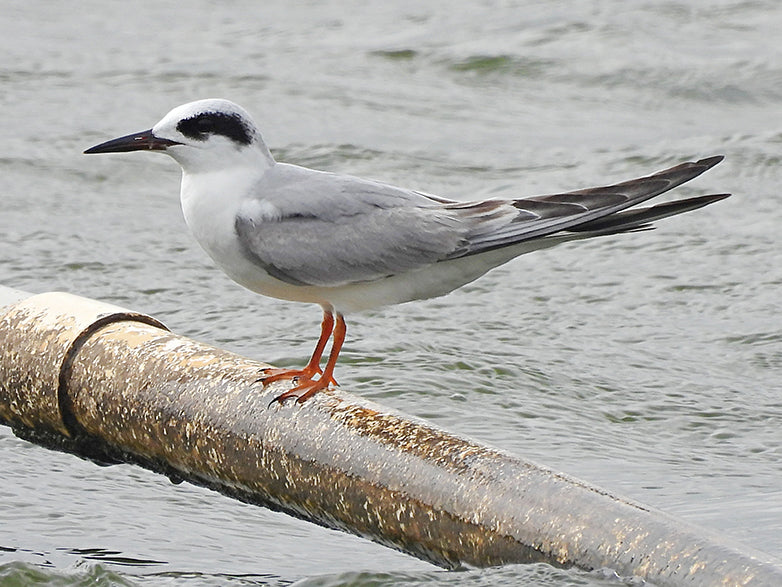
Forster's Tern
Sterna forsteri
Spanish Name: Gaviotín de Forster
Vagrant
Size: 13 in | 33 cm
Habitat: coastal areas, salt marshes, freshwater marshes, lakes, rivers, and estuaries.
Height: Sea level
Photo: © passion4nature iStock/Getty Images Plus

Elegant Tern
Thalasseus elegans
Spanish Name: Gaviotín Elegante
Size: 17 in | 43 cm
Habitat: Along the Pacific coast of North and South America, nesting on coastal islands, sandbars, and beaches. They prefer open coastal areas, estuaries, and bays for feeding and breeding.
Height: Sea level
Photo: © Brian Sullivan eBird S24954051 Macaulay Library ML 27381271

Sandwich Tern
Thalasseus sandvicensis
Spanish Name: Gaviotín de Cabot
Size: 15 in | 38 cm
Habitat: Coastal lagoons, estuaries, and salt marshes. During the non-breeding season, they migrate to warmer waters in southern regions.
Height: Sea level
Photo: © Wirestock iStock/Getty Images Plus
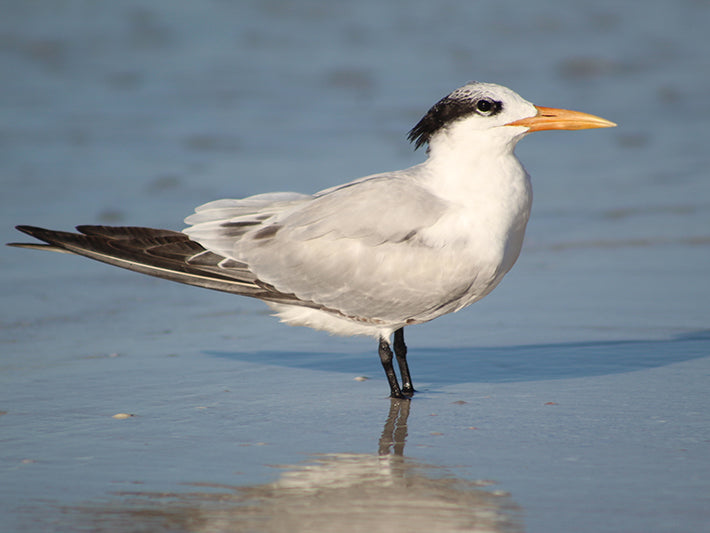
Royal Tern
Thalasseus maximus
Spanish Name: Gaviotín Real
Size: 21 in | 51 cm
Habitat:
Height: Sea level
Photo: © Gina Picchi iStock/Getty Images Plus

